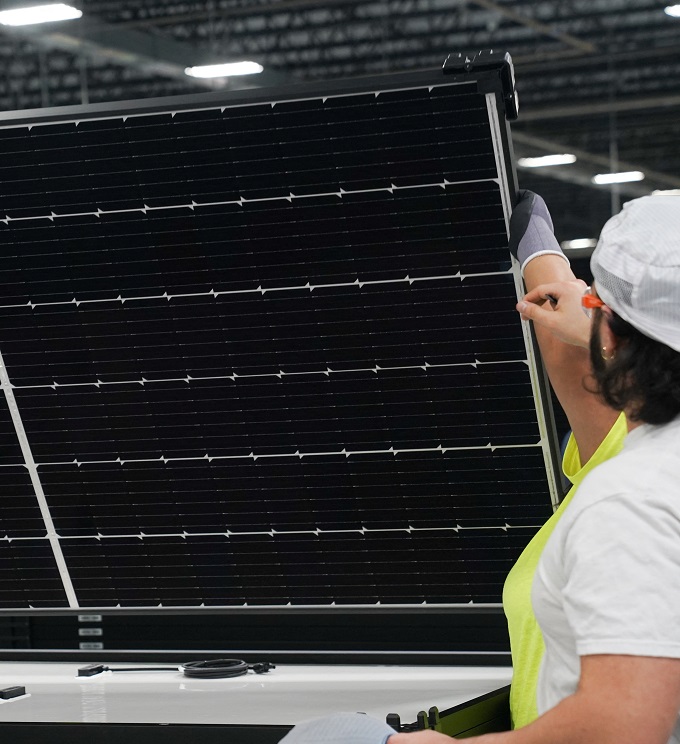Largest ever US solar factory shows rapid pivot to American made
Boosted by the Inflation Reduction Act, U.S. solar developers are investing in new factories in a rush to secure domestic capacity.

Related Articles
A plan by U.S. developer Invenergy and China's Longi to build the U.S.' largest solar panel factory signals rapid growth ahead in U.S. manufacturing as developers wade into the supply market.
The 5 GW/year Illuminate USA facility will be located in Pataskala, Ohio and will supply monofacial and bifacial solar panels to the utility-scale and rooftop solar markets.
Invenergy is the largest independent renewable energy developer in the U.S. and will be the majority owner and anchor customer of the facility, purchasing 40% of all output, an Invenergy spokesperson told Reuters Events.
The company will invest $600 million in the project, including a $220 million commitment to acquire and build out a vacant 1.1 million-square-foot industrial building, allowing a rapid start-up of production lines by the end of this year and full capacity by the end of 2024.
Until now, most U.S. solar projects have sourced panels from Asia, where costs are lower, but international supply risks have worsened since the coronavirus pandemic. Customs delays, uncertainty over tariffs and soaring global demand have hiked import costs and with U.S. deployment set to soar, more developers are seeking domestic products to reduce delivery risks.
Tax credits for clean tech manufacturing in the Biden administration's Inflation Reduction Act have significantly improved the business case, an Invenergy spokesperson said.
The tax credits send a "much-needed long-term signal to the marketplace” and will make domestic solar products competitive with imports, the spokesperson said.
Developers commit
Solar companies have announced plans for 47 GW of new U.S. module manufacturing capacity on the back of the inflation act and other government policies, the Solar Energy Industry Association (SEIA) said in a statement in March.
The U.S. had only 8 GW/year of module production capacity at the end of 2022 and must install over 60 GW of solar per year from the middle of the decade to achieve President’s Biden’s climate goals.
US solar manufacturing announcements (Jan. 2023)
(Click image to enlarge)
Source: Department of Energy, January 2023
Invenergy decided to acquire a stake in the U.S. supply chain to ensure it could meet growing demand from U.S. customers, the company spokesperson said.
The Ohio facility represents a “generational step forward in systematically and strategically onshoring U.S. solar technology development, manufacturing and distribution,” the spokesperson said.
Italian renewable energy developer Enel has also announced plans to build a 3 GW solar panel and cell factory in the U.S. and currently sees Oklahoma as the most likely location, the company said on April 25.
The investment model used by Invenergy could be replicated by other developers, Brittany Smith, Solar Techno-Economic Analyst at National Renewable Energy Laboratory (NREL), told Reuters Events.
A new U.S. Solar Buyer Consortium created last year demonstrates the demand for U.S.-made products, Smith noted.
Set up by developers AES Corporation, Clearway Energy Group, Cypress Creek Renewables and D. E. Shaw Renewable Investments, the consortium commits to spend over $6 billion to purchase roughly 7 GW/year of U.S. solar modules, starting in 2024.
Ohio builds
Ohio, Georgia and South Carolina are quickly becoming solar manufacturing hubs, SEIA said in March.
First Solar, the largest U.S. based solar manufacturer, is based in Ohio and is currently expanding its factory south of Cleveland towards a goal of 11 GW of U.S. production capacity by 2026.
Ohio has attractive industry electricity rates at 10% lower than the national average and wage rates for production roles are also below average levels, Eric Wright, Senior Research Analyst, S&P Global Commodity Insights, told Reuters Events.
It's location between the Northeast, Southwest and Midwest markets allows distribution along major interstate corridors, he added.
Clean technology manufacturing also improves job prospects for Ohio communities as demand for renewable energy rises and more coal plants close in the region.
Invenergy already operates around 775 MW of solar in Ohio and a raft of other projects are being developed in the state, including EDF’s 577 MW Fox Squirrel and Acciona’s 325 MW Union Solar projects.
Workers association JobsOhio will work with Invenergy and its factory partners to develop training and skills programs and recruit workers.
Upstream gaps
Invenergy's Ohio facility would help pave the way for a complete domestic supply chain, the company said.
Solar manufacturing capacity by country, region
(Click image to enlarge)
Source: International Energy Agency's Report on Solar PV Global Supply Chains, August 2022
It will take time to build a truly domestic supply chain as the U.S. currently has limited production capacity in polysilicon, wafers and cells but the inflation act appears to have catalysed interest in upstream activities as well as panel assembly.
"Enel, Qcells and Silfab have announced efforts to manufacture solar cells in the United States, and ingot wafer manufacturers are also readying efforts to launch domestic capacity," SEIA said in March.
By 2026, U.S. manufacturing capacity for polysilicon, wafers, cells, and modules could reach 30 GW, 26.3 GW, 13.13 GW and 51.7 GW respectively, based on known announcements, Wright said.
According to S&P analysis, the inflation act slices the cost of U.S.-made wafers by as much as 52% and reduces the cost of cells by 29%. Despite these savings, some manufacturers building vertically integrated supply lines may opt to import wafers from mainland China, Wright said.
China currently supplies around 97% of global wafer production and some developers are not yet convinced it would be “optimal to manufacture wafers domestically," he said.
Reporting by Neil Ford
Editing by Robin Sayles


